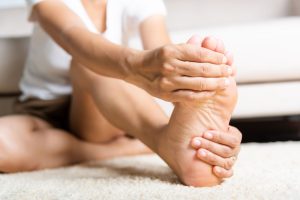Many people are familiar with rheumatoid arthritis (RA) as being a condition that affects the hands and wrist, though it can also be present in the foot and ankle. Rheumatoid arthritis is a chronic disease that attacks multiple joints throughout the body. It can affect the same joint on both sides of the body. The synovial membrane that lines the joint begins to swell, which results in pain and stiffness. Rheumatoid arthritis is an autoimmune disease which means the immune system attacks the body’s own tissues and damages the cartilage and ligaments while softening the bone.
About 20 percent of patients experience foot and ankle symptoms as the first sign of RA.
Symptoms Throughout the Foot and Ankle
The most common symptom of foot and ankle arthritis is pain and inflammation. Symptoms of RA typically appear in both feet, unlike osteoarthritis which usually affects one specific joint.
Forefoot (Toes and Ball of the Foot) – People with RA are prone to bunions, claw toes, and pain stemming from the ball of the foot (metatarsalgia). Bumps may develop of the ball of the foot, when bones in the midfoot are pushed down, causing calluses.
Midfoot (Top of the Foot) – RA causes the ligaments that support the midfoot to become weak and, as a result, the arch collapses. Without proper arch support, the front of the foot will migrate outward. Over time, this can create a bony prominence (bump) to form on the inside and bottom of the foot, changing the overall shape of the foot. This change in shape can make it difficult to find comfortable footwear or wear shoes at all.
Hindfoot (Heel Region) – In the initial stages of RA, people may experience difficulty walking on uneven ground or gravel. This is because the disease may shift the bones in the foot out of their normal positions, changing the overall alignment and impeding on the side-to-side motion of the heel region. Pain beneath the fibula (smaller lower leg bone) on the outside of the foot or discomfort along the posterior tibial tendon (main tendon that supports the foot arch) may indicate rheumatoid arthritis.
Ankle – Symptoms may include difficulty navigating inclines such as ramps or stairs. As the disease progresses, walking and standing may become uncomfortable or painful.
Nonsurgical Treatment
Treatments for rheumatoid arthritis of the foot and ankle will depend on the severity of the disease. Nonsurgical treatment options include:
- Physical Therapy – to safely stretch and strengthen the foot and ankle joints, and improve mobility and function.
- Medications such as non-steroidal anti-inflammatories (NSAID’s), like ibuprofen or naproxen, to reduce pain and inflammation.
- Assistive devices such as orthotics or braces, which will help minimize the pressure from prominent bones/bumps of the foot or support the joints of the foot and ankle.
- Corticosteroid (cortisone) injections – typically a temporary measure to reduce inflammation in the joint.
Surgical Treatment
Your doctor may recommend surgery if nonsurgical treatment options for arthritis symptoms fail to provide pain relief, or if there is extensive cartilage damage. The goal of surgery is to relieve the pain of arthritis and make it possible to perform daily activities more easily.
Fusion of the affected joints is the most common type of surgery performed for RA[1]. This procedure involves taking two bones that form a joint and fusing them together into one bone. During the surgery, remaining cartilage is removed and the two bones are held together with screws and plates, preventing the bones from moving. Fusion reduces pain by limiting joint motion and preventing further shifting.
Other surgical options are available to address issues related to rheumatoid arthritis of the foot and ankle. The surgeon will discuss the appropriate options for each individual case.
Schedule an appointment
The Raleigh Orthopaedic Clinic board-certified, fellowship-trained foot and ankle specialists, Dr. Boone, Dr. Casale, and Dr. Logel, provide comprehensive and specialized care for a wide variety of foot and ankle conditions. They also work closely with Raleigh Orthopaedic Clinic’s podiatrist, Dr. Simmons, to utilize conservative treatment options whenever possible. The foot and ankle specialists at Raleigh Orthopaedic are dedicated to quality outcomes and are trained to treat strains, sprains, fractures, tendon injuries, and more. Our foot and ankle specialists are available at all of our clinics in Wake County, NC.
Raleigh Orthopaedic offers online scheduling so click the button below or call us at (919) 781-5600 to schedule an appointment with one of our orthopedic specialists.
The material contained on this site is for informational purposes only and DOES NOT CONSTITUTE THE PROVIDING OF MEDICAL ADVICE, and is not intended to be a substitute for independent professional medical judgment, advice, diagnosis, or treatment. Always seek the advice of your physician or other qualified healthcare providers with any questions or concerns you may have regarding your health.
[1] https://orthoinfo.aaos.org/en/diseases–conditions/rheumatoid-arthritis-of-the-foot-and-ankle/
